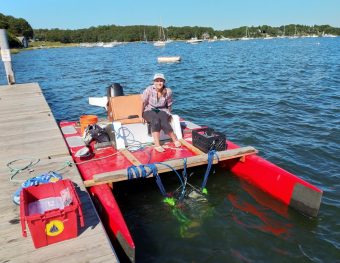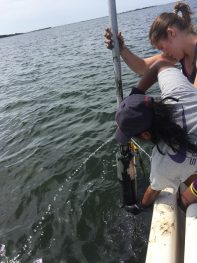Northeast Regional Ocean Council: Initiating new monitoring activities to accelerate implementation of the regional ocean and coastal acidification monitoring plan
Project Title: Northeast Regional Ocean Council (NROC): Initiating new monitoring activities to accelerate implementation of the regional Ocean and Coastal Acidification monitoring plan
Duration: October 2025 – October 2026
Funding Source: NERACOOS
Principal Investigator: Brian Helmuth, Northeastern University
Contact: b.helmuth@northeastern.edu
Project Description: The goal of this project is to identify thermal microhabitats within which shell-forming organisms that are vulnerable to ocean and coastal acidification might take refuge from low pH conditions, and to assess the potential buffering capacity of different habitat types to extreme heat and extreme cold events. We will deploy 10 microsensors within each of three sites within each of five NERR sites, including Waquoit Bay, for a total of 30 sensors per NERR and 150 across the network. Replicate sensor deployments of ElectricBlue ENVloggers will help to characterize the mean and extreme temperatures within hard substrate and soft substrate (marsh) intertidal sites, as well as shallow water sites where eelgrass either currently or historically has existed. Because data can be downloaded from any cell phone, we will also work with the NERR education coordinator to establish citizen science protocols that complement ongoing work at the Waquoit Bay NERR.
Spatial mapping of dissolved inorganic carbon across Waquoit Bay
Project Title: Spatial mapping of dissolved inorganic carbon across Waquoit Bay
Duration: (month/year to month/year): Mid-late Sept 2021
Funding Source(s): MIT Seagrant, NOAA OER, NSF
Principal Investigator: Mallory Ringham
Affiliation: MIT-WHOI
Email: mringham@whoi.edu
 Project Description: Study of the marine CO2 system is critical for understanding global carbon cycling and the impacts of changing ocean chemistry on marine ecosystems. A complete resolution of the marine CO2 system requires simultaneous measurement of two out of four parameters: partial pressure of CO2 (pCO2), dissolved inorganic carbon (DIC), total alkalinity (TA), and pH. Currently, commercial sensors are only available for pCO2 and pH, which often are difficult to deploy in turbid coastal environments, and traditional bottle sampling for seawater carbon chemistry prohibits measurements during poor weather or at night. We have been developing a new sensor, the CHAnnelized Optical System (CHANOS) II for high resolution autonomous DIC measurements. This sensor may be deployed from a stationary dock, mooring, or buoy for long term time-series analyses, or towed from a vehicle such as a ship, AUV, ROV, or CTD rosette. We will be towing this sensor, along with a suite of dissolved oxygen and commercial pH and pCO2 sensors, across Waquoit Bay to test the sensor capabilities in creating a high-resolution surface map of DIC across high and low tidal cycles.
Project Description: Study of the marine CO2 system is critical for understanding global carbon cycling and the impacts of changing ocean chemistry on marine ecosystems. A complete resolution of the marine CO2 system requires simultaneous measurement of two out of four parameters: partial pressure of CO2 (pCO2), dissolved inorganic carbon (DIC), total alkalinity (TA), and pH. Currently, commercial sensors are only available for pCO2 and pH, which often are difficult to deploy in turbid coastal environments, and traditional bottle sampling for seawater carbon chemistry prohibits measurements during poor weather or at night. We have been developing a new sensor, the CHAnnelized Optical System (CHANOS) II for high resolution autonomous DIC measurements. This sensor may be deployed from a stationary dock, mooring, or buoy for long term time-series analyses, or towed from a vehicle such as a ship, AUV, ROV, or CTD rosette. We will be towing this sensor, along with a suite of dissolved oxygen and commercial pH and pCO2 sensors, across Waquoit Bay to test the sensor capabilities in creating a high-resolution surface map of DIC across high and low tidal cycles.
Forecasting Rates of Sediment Nutrient and Metal fluxes under Coastal Acidification
Title: Forecasting rates of sediment nutrient and metal fluxes under coastal acidification for improved estuarine water quality
Year: 2020-2022
Principal Investigator/contact information:
Claudia I. Mazur (she/her)
Ph.D. Candidate, Fulweiler Lab
NOAA Margaret A. Davidson Fellow
Earth & Environment, Boston University
Email: cmazur@bu.edu
Lab Website: fulweilerlab.com
 Abstract: Coastal acidification refers to the reduction in pH of coastal waters. Unlike the open ocean, coastal acidification is driven by excess nitrogen (N). This N fuels primary productivity and the subsequent decomposition of this organic matter lowers estuarine pH. In fact, estuaries experience pH shifts of ≥ 0.5 daily. Thus, estuaries are natural laboratories in which to study how acidification alters fundamental ecosystem processes such as nutrient filtration and cycling. The purpose of this research is to determine the impact of coastal acidification on sediment N, phosphorus (P), and iron (Fe) cycling. To address this issue, I will experimentally manipulate pH in the overlying water column of sediment cores collected from Waquoit Bay, MA. Using continuous flow through incubations, I will quantify rates of sediment denitrification (microbial removal of N to di-nitrogen gas), N, P and Fe fluxes. I will use these findings and data from the WBNERR System-Wide Monitoring Program to develop a model that will predict the impact of low pH conditions on these fluxes and future water quality in Waquoit Bay. This study will be a crucial link to understanding how coastal acidification alters total ecosystem productivity, biogeochemical cycling and water quality.
Abstract: Coastal acidification refers to the reduction in pH of coastal waters. Unlike the open ocean, coastal acidification is driven by excess nitrogen (N). This N fuels primary productivity and the subsequent decomposition of this organic matter lowers estuarine pH. In fact, estuaries experience pH shifts of ≥ 0.5 daily. Thus, estuaries are natural laboratories in which to study how acidification alters fundamental ecosystem processes such as nutrient filtration and cycling. The purpose of this research is to determine the impact of coastal acidification on sediment N, phosphorus (P), and iron (Fe) cycling. To address this issue, I will experimentally manipulate pH in the overlying water column of sediment cores collected from Waquoit Bay, MA. Using continuous flow through incubations, I will quantify rates of sediment denitrification (microbial removal of N to di-nitrogen gas), N, P and Fe fluxes. I will use these findings and data from the WBNERR System-Wide Monitoring Program to develop a model that will predict the impact of low pH conditions on these fluxes and future water quality in Waquoit Bay. This study will be a crucial link to understanding how coastal acidification alters total ecosystem productivity, biogeochemical cycling and water quality.
Quantifying Coastal Ocean Acidification Impacts on Estuarine Nitrogen Removal
Project Title: Quantifying Coastal Ocean Acidification Impacts on Estuarine Nitrogen Removal
Date: 6/2019-6/2020
Principal Investigator(s): Robinson Fulweiler
Affiliations: Boston University
Summary: Ocean acidification in estuarine systems is expected to influence the biogeochemical cycling of nitrogen, a nutrient necessary for life. In estuarine systems, sediment denitrification is a natural microbial process that removes excess nitrogen and helps decrease the negative impacts of eutrophication. Evidence shows that sediment microbial communities that play a role in regulating denitrification are correlated with pH. For example, as pH decreases, the denitrification efficiency also decreases. This incomplete denitrification can lead to an increased production of nitrous oxide, a potent greenhouse gas that is 300 times more powerful that carbon dioxide. Yet, the impact of pH on marine sediment communities in general, and denitrifies in particular, has largely gone unexplored. In this study we will assess the impact of coastal acidification on sediment denitrification.
To address this topic we will (1) characterize the potentially active sediment microbial community under different pH regimes. (2) Couple the rates of denitrification to the key functional genes of the denitrifying community. (3) Experimentally alter the water column pH to test coastal acidification impacts on sediment denitrification processes and the active microbial community.
Oxygen metabolism and pH in coastal ecosystems: Eddy Covariance Hydrogen ion and Oxygen Exchange System (ECHOES)
Project Title: Oxygen metabolism and pH in coastal ecosystems: Eddy Covariance Hydrogen ion and Oxygen Exchange System (ECHOES)
Date: 2015
Principal Investigator(s): Long, M.H., Charette, M.A., Martin, W.R., & McCorkle, D.C.
Abstract: An aquatic eddy covariance (EC) system was developed to measure the exchange of oxygen (O2) and hydrogen ions (H+) across the sediment‐water interface. The system uses O2 optodes and a newly developed micro‐flow cell H+ ion selective field effect transistor; these sensors displayed sufficient precision and rapid enough response times to measure concentration changes associated with turbulent exchange. Discrete samples of total alkalinity and dissolved inorganic carbon were used to determine the background carbonate chemistry of the water column and relate the O2 and H+ fluxes to benthic processes. The ECHOES system was deployed in a eutrophic estuary (Waquoit Bay), and revealed that the benthos was a sink for acidity during the day and a source of acidity during the night, with H+ and O2 fluxes of ± 0.0001 and ± 10 mmol m−2 h−1, respectively. H+ and O2 fluxes were also determined using benthic flux chambers, for comparison with the EC rates. Chamber fluxes determined in 0.25 h intervals co‐varied with EC fluxes but were ∼ 4 times lower in magnitude. Read full text…Limnology and Oceanography: Methods, 13(8), 438-450. http://onlinelibrary.wiley.com/doi/10.1002/lom3.10038/full
Collaborative Research


